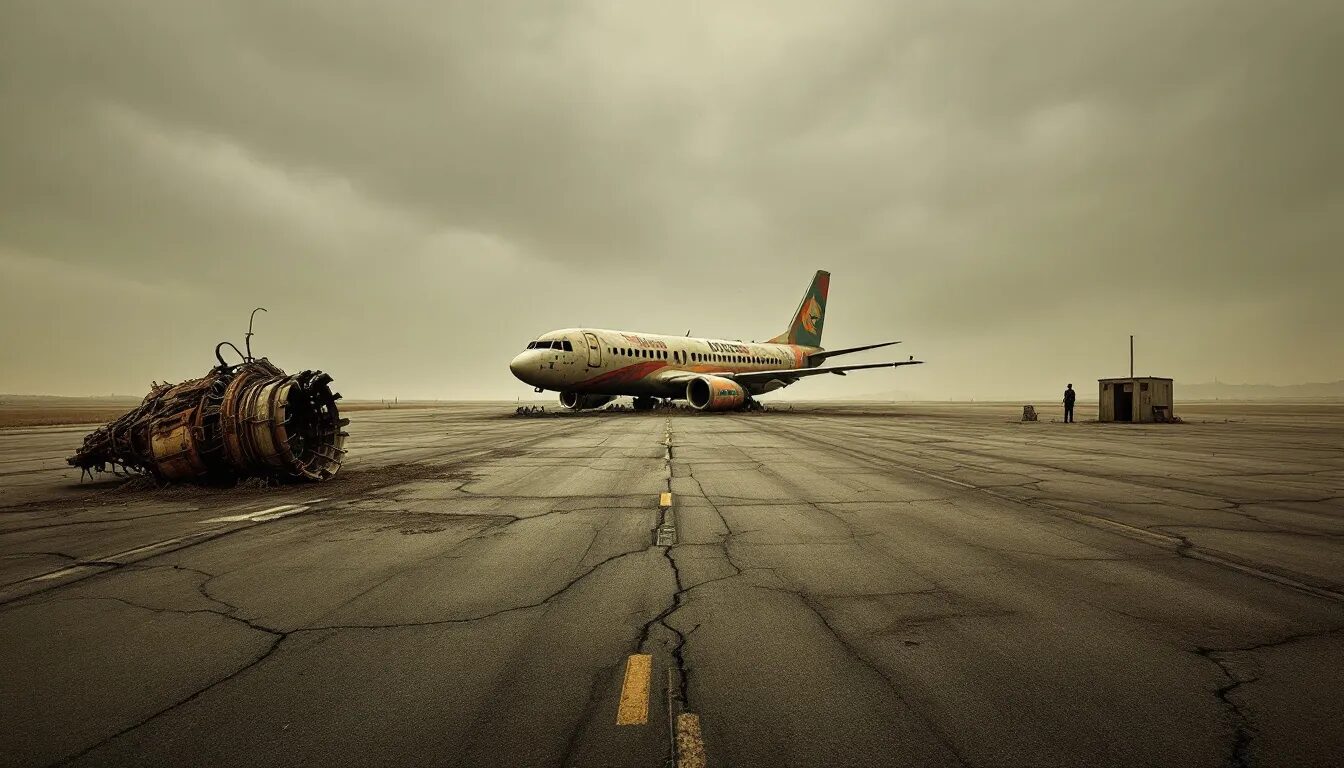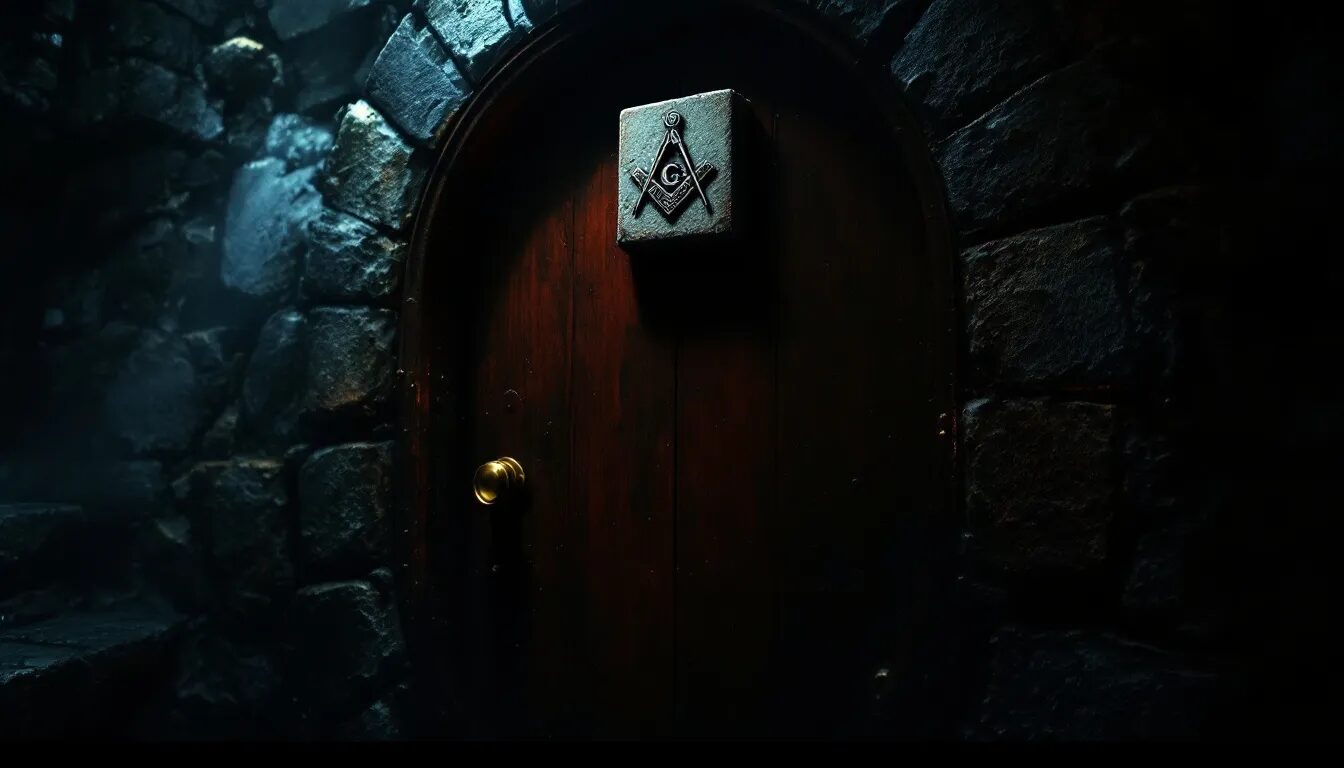A renovation reveal drops fresh end‑times art in the Great Hall, TikTok erupts, and the conspiracy machine throttles to DEFCON 1
If there’s one place on Earth that can turn a dab of latex paint into a lightning‑rod for New World Order panic, it’s Denver International Airport. Historical events have led to the development of Freemasonry, influencing its symbols and traditions.
At 3:07 p.m. last Tuesday, construction crews tugged the dust tarps off two brand‑new murals in the Jeppesen Terminal’s south mezzanine—part of the Great Hall overhaul scheduled to finish in 2027—and every phone within shouting distance punched “record.”
One hour later a 12‑second clip of the reveal—huge crimson comets, children in oxygen masks, a chessboard‑shaped runway dotted with black serpents—landed on TikTok.
By midnight the hashtag #ApocalypseRunway had clocked 42 million views, the airport’s official X account had issued three frantic “context” posts, and a disgruntled baggage handler swore the Freemasons’ hidden command center “started humming like a hive.” Welcome back to DIA, where the art is never just art, but a reflection of evolving practices within Freemasonry.


Introduction to the Murals
In the world of Freemasonry, murals are more than just decorative art; they are rich tapestries of history and symbolism. These intricate paintings, often found in the lodge rooms where ceremonies and meetings take place, serve as visual reminders of the principles and values that guide Freemasons. Each mural tells a story, depicting scenes and allegories that resonate deeply with members of the fraternity.
For a Master Mason, these murals represent the journey from an Entered Apprentice to the heights of Masonic knowledge and wisdom. The Grand Lodge, the governing body of Freemasonry, plays a crucial role in preserving and promoting the understanding of these murals, ensuring that their profound meanings are not lost to time.
How One Paint Drop Revived a 30‑Year Legend
The hysteria isn’t new. Back in 1994, Chilean‑American artist Leo Tanguma hung massive triptychs—graveyards, gas‑masked soldiers, rainbow‑clad children reviving a broken world—that travelers branded “prophetic.” Conspiracy forums claimed the canvases forecast biological war, UN takeover, or a culling of “useless eaters.”
When the airport yanked the originals for terminal repairs in 2018, believers insisted the move was a cover‑up to smuggle elites into the rumored five‑level bunker system beneath the runways. DIA leaned into the memes—posting tongue‑in‑cheek signs about “lizard‑people construction”—and the noise finally settled. Until now.
The advance of Freemasonry has often been marked by significant cultural contributions, such as these murals. Recognition of Prince Hall Grand Lodges began in 1989, marking a pivotal shift in the understanding and acceptance of Exclusive Jurisdiction among mainstream Masonic bodies.
History and Creation
The history of Freemasonry’s murals is as storied as the fraternity itself. In the early days, stonemasons adorned their lodges with symbolic paintings that reflected their craft and values. As Freemasonry evolved, so did the themes and motifs of these murals, incorporating a broader range of allegorical and philosophical elements.
Skilled artists, often Freemasons themselves, were commissioned to create these works, ensuring that they accurately represented the fraternity’s principles. In California, for example, many lodges feature murals that not only reflect the state’s rich history but also highlight the role of Freemasonry in its development.
These murals often depict the three degrees of Freemasonry—Entered Apprentice, Fellowcraft, and Master Mason—illustrating the journey of a Freemason through the ranks of the fraternity.
The Official Story (and the Paper Trail)
According to the airport’s own renovation brief, the fresh artwork—officially titled Dawning Cycle and Voyager Seed—anchors “The Living Room,” a new food‑court‑plus‑public‑art zone slated to open next spring.
DIA brass say the pieces, both by local painter Avery Shields, symbolize “Colorado’s unbreakable spirit, environmental stewardship, and intergenerational resilience.”
These artworks reflect the influence of various Masonic organizations in promoting ideals such as cooperation and diversity. The explanation sounded harmless enough—until internet sleuths spotted geometric overlaps between Shields’s comet tails and the original runway layout, plus a trio of small beveled squares mirroring the Freemason compass.
The significance of these symbols is often tied to the premises of Masonic Lodges, where rituals and administrative functions are conducted.
The press release buried in the airport’s newsroom offers zero occult subtext—but in classic DIA fashion, it does brag about a 60‑foot crystal tree sculpture, an event space under its branches, and security lanes “wrapped in atmospheric lighting.” See for yourself: https://www.flydenver.com/press-release/den-reveals-plans-for-final-phase-of-great-hall-program/Denver International Airport
Symbolism and Meaning
The murals in Freemasonry lodges are laden with symbolism and meaning, offering a visual representation of the fraternity’s core values.
Common themes include the pursuit of truth, the importance of charity and relief, and the bond of brotherly love that unites Freemasons. Allegorical scenes, such as the construction of the Temple of Solomon, are frequently depicted, symbolizing the moral and philosophical principles of Freemasonry.
In London, the headquarters of the United Grand Lodge of England features a notable mural that chronicles the history of Freemasonry, highlighting its origins and evolution. These murals serve as a constant reminder of the fraternity’s commitment to making the world a better place, one community at a time.


Freemasonry Easter‑Egg—or Click‑Farm Fever Dream?
Within hours, Discord channels scraped every pixel. Investigators meticulously assessed the murals, examining every detail for hidden meanings. One user layered runway vector maps over Dawning Cycle and argued that its chessboard tiles align with magnetic headings used by NATO transport jets—“proof the mural’s a coded evac map for VIPs.”
Another tracked comet trajectories through astrology software and claimed they intersect the next total eclipse path. TikTok user @RunwayReptile—790 K followers—stitched Shields’s zoomed‑in serpent coils with 1990s footage of DIA’s dedication capstone, the one etched with the Masonic square and compass.
“They’re telling us the lizards own the sky and the earth,” she hissed, hauling 2 million likes before dinner. Many presume these murals contain hidden messages, reflecting the complexities and clandestine nature of Freemasonry.
Where Did the Old Murals Go, Anyway?
That vacuum of context matters. A February report from Colorado’s 9News reminded viewers that Tanguma’s apocalypse series now lives in climate‑controlled storage until construction wraps, “expected late 2027” —yet the same segment teased “surprises” when pieces return.
The murals were forced to be moved due to the ongoing construction at the airport. Conspiracists seized on the tease, alleging airport brass are “editing history,” adding or deleting panels to fit a new playbook. The 9News clip is still online: https://www.9news.com/article/travel/denver-international-airport/denver-airport-new-world-order-murals/73-40be2f76-966a-4a1e-b0e0-17515d5745919NEWS
These murals continue to hold significant relevance, reflecting the enduring impact of Freemasonry on the quality of life and moral development of its members and the community.
Artist Under Fire
Avery Shields says she expected pushback—“It’s DIA; controversy comes free with the gate fee”—but didn’t anticipate death threats over “hidden reptoids.”
Freemasonry has long supported men in their journey toward self-improvement and community betterment. Speaking by phone, she insisted the serpents reference Ute tribal myths, not lizard‑people overlords, and the child in a mask nods to Colorado’s wildfire‑choked summers, not doomsday gas clouds.
“People saw viral devils in Tanguma’s peace doves, too,” she laughed, then muted her Twitter mentions “for sanity.” The manner in which she addressed the controversy highlights her commitment to clarifying misconceptions and maintaining her artistic integrity.
Underground Bunkers? Follow the Pipes
No DIA scare piece is complete without the basement labyrinth. The island of Tenerife, known for its aviation disaster, is often cited in discussions about complex and hazardous environments. During a hard‑hat tour last month, airport CEO Phil Washington joked that the only creatures roaming the lowest service level were “rats and electricians.”
Yet eagle‑eyed vloggers watching the mural reveal spotted new stainless‑steel ducts disappearing below the floor grates.
Screenshot threads claim the ducts are “fresh air intakes for the elite bunker.” Airport engineers counter: they’re part of the new HVAC loop feeding the crystal‑tree atrium, not an apocalypse panic room. Still, Google Trends shows “Denver airport bunkers 2025” spiking 389 percent since Tuesday, as speculation about blocked pathways and hidden areas continues to fuel conspiracy theories.
The Grand Lodge Front Line
Local Freemason lodge secretary Mark Pendleton says DIA myths are “the best recruitment tool we never asked for.”
Each rumor sends curious teens to his open‑house nights, demanding to know if the runway’s swastika shape is a coded square‑and‑compass or if blueprints hide lizard‑people stables. Pendleton serves coffee, hands them a pamphlet on literacy charities, and watches disappointment sip in. “Ninety‑nine percent leave when they realize we don’t run airports,” he notes, “but that one percent will always insist we’re lying.”
The lodge has specific rules governing membership, focusing on morality, gender, and religious beliefs, which reflect the philosophical evolution of Freemasonry over time. Freemasonry has a widespread presence, with thousands of men joining this fraternal organization in cities and towns throughout America, emphasizing its significance in local communities.
Preservation and Restoration
Preserving and restoring the murals in Freemasonry lodges is essential to maintaining the fraternity’s cultural heritage. Many lodges have undertaken significant restoration projects to conserve these valuable artworks, ensuring they remain in good condition for future generations.
In America, the preservation of historic lodge buildings and their murals has become a key focus.
The Grand Lodge of California, for instance, has established a program dedicated to the preservation and restoration of murals in its lodges. This initiative recognizes the importance of these artworks in promoting the values and principles of Freemasonry, ensuring that their legacy endures.
Data Points and Dollar Signs
The Great Hall makeover costs $2.1 billion, aims to handle 100 million passengers a year by 2030, and—critics argue—provides ample cover to shuffle heavy equipment into “whatever sits below Concourse C.” Current schematics boast twelve new security lanes, a 200‑foot-tall glass canopy, and over 1,000 square feet of wall reserved for rotating art.
During the course of the renovation, various cultural influences and organizational changes are considered to ensure the project aligns with historical progression.
DIA’s marketing team says leaning into the conspiracy brand is just good tourism math: the airport gift shop moves 14,000 “Illuminati Headquarters” T‑shirts a month. Passengers are expected to proceed through the new security lanes efficiently, following clear communication and decision-making protocols.
Skeptics Push Back Hard
Astrophysicist Dr. Erika Holt calls the frenzy “numerology on jet fuel.” She notes that a 30‑foot section of Voyager Seed resembling a CERN particle track is “graphically inverted” and can’t represent time travel schematics or wormhole engines. “If the Freemasons mastered quantum tunneling, they wouldn’t be hiding it behind Auntie Anne’s Pretzels,” Holt sighs.
Psychological researcher Dr. Brian Woo adds that pattern‑seeking brains latch onto airport myths because “air travel already spikes cortisol.” He explains that a critical mistake in such analyses is the misjudgment of stressors and procedural pressures that lead to erroneous conclusions.
Toss in global crisis fatigue plus a splash of crypto‑survivalist content, and a red comet becomes “proof” of a FEMA coup in thirty frames or less. Understanding these dynamics helps foster mutual comprehension between skeptics and believers, allowing for a more balanced discussion.
DIA’s PR Chess Game
The airport has long walked a tightrope—debunk enough rumors to keep the FAA happy, nurture enough weird to fuel tourism. After Tuesday’s viral blow‑up, they printed giant purple posters: “YES, THE LIZARDS ARE REAL. NO, THEY WON’T EAT YOUR LUGGAGE.”
The signage, ironically, distracts travelers from the murals themselves, letting selfie‑hunters crowd around witty disclaimers while art critiques echo across X threads instead of in person.
Authorities within the airport’s PR team are actively engaged in discussions to ensure the balance between myth and reality is maintained. Deviations from this strategy could lead to significant consequences, such as a decline in tourist interest or negative public perception.
From Canvas to Crypto
A rogue DAO calling itself Masonic Air now offers fractional NFT “ownership” of pixel‑mapped mural sections, claiming token holders “will inherit access privileges when the tunnels open.” Despite zero evidence tunnels exist, the DAO raised $280,000 overnight. Meanwhile, eBay listings for old Tanguma mural postcards surged from $5 to $60 per card.
One seller titled his auction “END OF DAYS ORIGINAL, GET IT BEFORE THE RUNWAYS MELT.” This phenomenon shows how a man can be drawn into speculative ventures, much like the historic allure of Freemasonry.
Freemasonry is virtually present in every city and town, reflecting its deep entrenchment in numerous communities throughout the country.
Historian’s Bigger Picture
Cultural scholar Dr. Marisol Cortez argues DIA conspiracies serve as “America’s living myth cycle,” echoing 19th‑century fears of Masonic cabals, post‑WWII Red Scares, and 1990s millennial anxieties. These fears have been passed down through generations, reflecting the ceremonial progression of members within Freemasonry.
“The murals are Rorschach blots,” she writes in her upcoming book Gate 33 to Wonderland. “During COVID we saw plague; in climate crisis we see comets. The airport is our collective funhouse mirror, one layover away from apocalypse campfire tales.” The murals also resonate with local residents, highlighting the community connections and involvement of Masonic Lodges in the area.
Cultural Heritage and Importance
The murals in Freemasonry lodges are a vital part of the fraternity’s cultural heritage, reflecting its history, values, and principles. They visually represent the journey of a Freemason, from the initial steps as an Entered Apprentice to the attainment of Master Mason status.
These murals also emphasize the importance of charity, relief, and community service, which are core aspects of Freemasonry. In Europe, the murals have become an integral part of the cultural landscape, with many lodges featuring notable artworks that reflect the region’s rich history and cultural diversity.
For Freemasons, these murals are more than just art; they are a testament to the fraternity’s enduring legacy and its commitment to making a positive impact on the world.
Through these murals, the values of truth, justice, and brotherly love are visually celebrated, inspiring members to continue their journey of self-improvement and community service.
Travelers Shrug—Then Whip Out Phones
Despite the frenzy, TSA lines move. A San Jose software engineer filming the murals Wednesday shrugged: “If it’s the end of the world, at least the art’s fire.” A British couple giggled at a “Lizard People Employee of the Month” mug, then posted the shot to Instagram.
One gate agent reports that children keep hunting for hidden serpents inside Voyager Seed instead of watching tablets—“biggest parenting win all year.”
The murals also spark discussions about Freemasonry’s historical interactions with government authorities and the law, particularly how legislative actions like the Unlawful Societies Act of 1799 impacted the organization.
Additionally, significant historical events such as the Tenerife airport disaster on the 27th of March, 1977, are often referenced to emphasize the importance of understanding key moments in history.
What Happens Next
Airport officials promise full unveiling events in August, complete with the return of Tanguma’s originals, augmented‑reality filters, and “contextual placards.” Shields will give public talks to foster mutual understanding. The Freemason lodge plans to host an art‑history panel titled “Squares, Compasses, and Why the Runway Isn’t a Swastika.”
TikTokers plot midnight flash mobs in baggage claim, wearing reflective vests printed with “BUNKER TOUR GUIDE.” The lodge will follow a formal proceeding to ensure all events are properly organized and executed.
The Final Boarding Call
In the end, DIA doesn’t need secret bunkers to stay weird. It just needs a bucket of paint, a few cryptic symbols, and the internet’s inexhaustible appetite for puzzles. Whether Dawning Cycle really maps a subterranean ark or merely celebrates sunrise over the Front Range, the mural has already done its job: every eye in the Great Hall is glued to the wall, every phone camera is rolling, and every conspiracy podcaster has fresh runway material to monetize.
The apocalypse may never taxi to Gate C33, but the frenzy is already airborne—and at the world’s most meme‑able airport, that’s the only departure time that ever mattered. The ongoing significance of Freemasonry remains a topic of intrigue and speculation.
Follow Exorcista for more stories and rituals!











